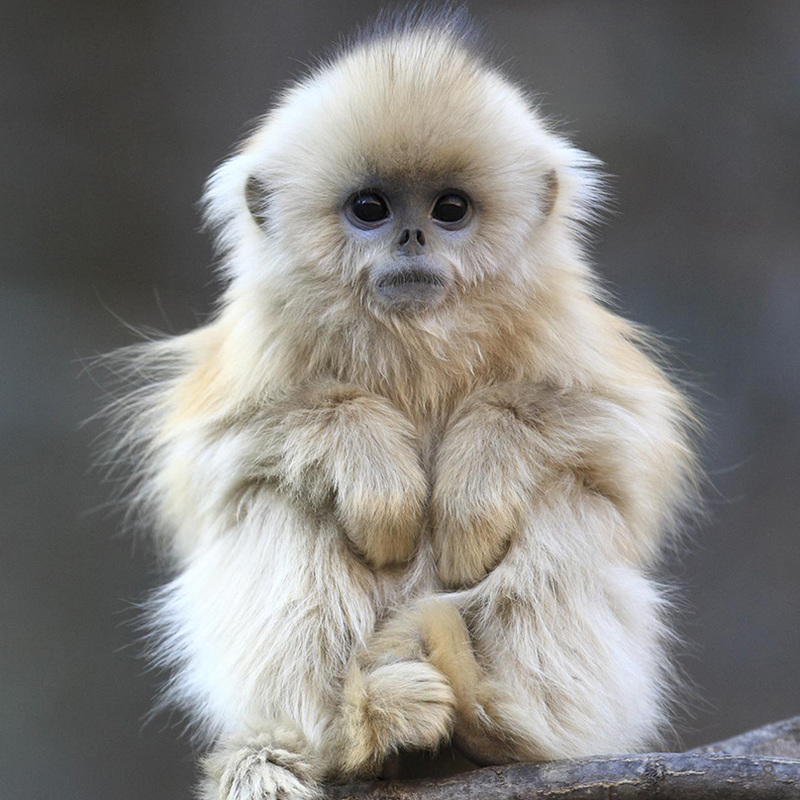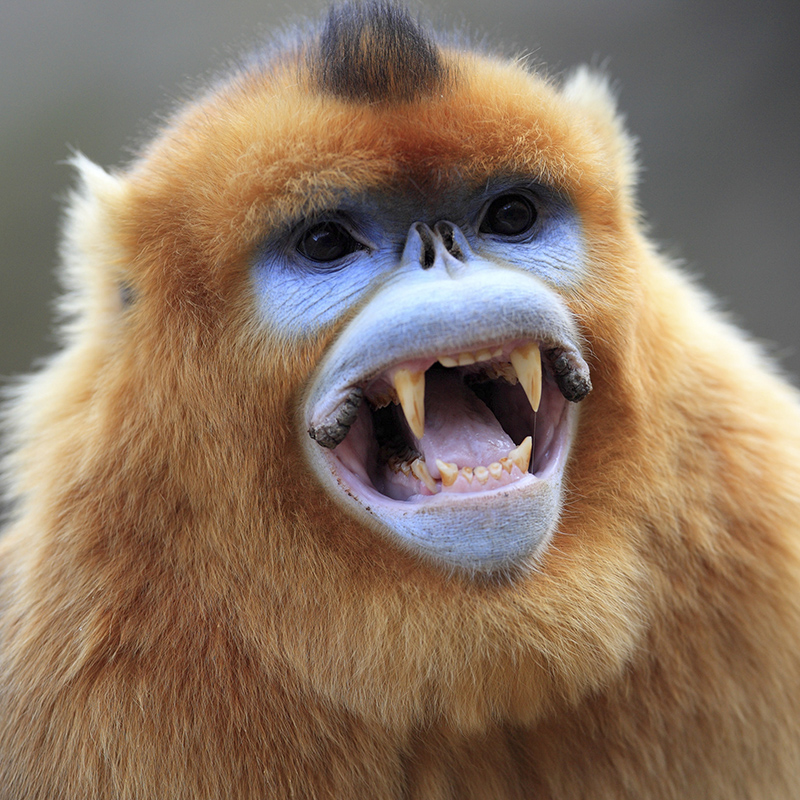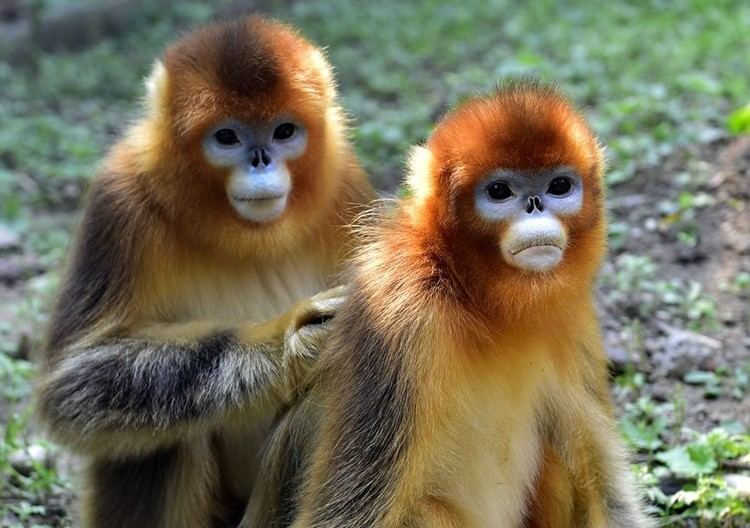Discover The Fascinating World Of The Golden Snub-Nosed Monkey
The golden snub-nosed monkey, scientifically known as Rhinopithecus roxellana, is one of the most unique and captivating primates in the world. Native to the mountainous regions of China, this rare species has captured the hearts of wildlife enthusiasts and scientists alike. With its striking appearance and intriguing behaviors, the golden snub-nosed monkey offers a glimpse into the incredible diversity of life on our planet.
Found primarily in the temperate forests of Central and Southwest China, this primate thrives in environments characterized by harsh weather conditions and high altitudes. Despite the challenging terrain, the golden snub-nosed monkey has adapted remarkably well, showcasing its resilience and adaptability.
As we delve deeper into the world of the golden snub-nosed monkey, we will explore its physical characteristics, habitat, behavior, and the conservation efforts aimed at protecting this endangered species. Understanding the life of this remarkable creature will not only deepen our appreciation for biodiversity but also emphasize the importance of preserving our natural ecosystems.
Read also:Unraveling The Mystery What Happened With Tamron Hall
Table of Contents
- Introduction to the Golden Snub-Nosed Monkey
- Physical Characteristics of the Golden Snub-Nosed Monkey
- Habitat and Distribution
- Diet and Feeding Habits
- Behavior and Social Structure
- Reproduction and Life Cycle
- Threats to the Golden Snub-Nosed Monkey
- Conservation Efforts
- Interesting Facts About the Golden Snub-Nosed Monkey
- Future Perspectives and Challenges
Introduction to the Golden Snub-Nosed Monkey
The golden snub-nosed monkey is an extraordinary primate species that belongs to the genus Rhinopithecus. This monkey is primarily found in the dense forests of Central and Southwest China, where it thrives in altitudes ranging from 1,500 to 3,400 meters above sea level. Its unique physical features, including its vibrant golden fur and distinctive upturned nose, make it one of the most recognizable primates in the world.
Scientific Classification
Scientifically, the golden snub-nosed monkey is classified under the family Cercopithecidae, which includes Old World monkeys. It is part of the subfamily Colobinae, a group of primates known for their specialized digestive systems that allow them to process tough plant materials efficiently.
Physical Characteristics of the Golden Snub-Nosed Monkey
One of the most striking features of the golden snub-nosed monkey is its golden fur, which gives it its name. The fur color varies slightly depending on the age and sex of the monkey, with adult males having longer and more vibrant fur compared to females and juveniles.
Distinctive Features
- Upturned Nose: The most notable feature of this species is its flat, upturned nose, which lacks a nasal septum. This adaptation helps the monkey survive in cold climates by preventing heat loss.
- Long Fur: Adult males have long, flowing fur, especially around their necks and shoulders, which serves as a display of dominance.
- Size and Weight: Adult males typically weigh between 15 to 20 kilograms, while females weigh around 8 to 12 kilograms. Their body length ranges from 57 to 76 centimeters.
Habitat and Distribution
The golden snub-nosed monkey is native to the mountainous regions of China, particularly in the provinces of Sichuan, Gansu, Hubei, and Shaanxi. These monkeys prefer temperate forests with dense canopies, where they can find shelter and food.
Adaptation to High Altitudes
Living at high altitudes, the golden snub-nosed monkey has developed unique adaptations to survive in cold climates. These include thick fur for insulation, a specialized digestive system for processing tough lichens and bark, and social behaviors that help maintain body heat during harsh winters.
Diet and Feeding Habits
The diet of the golden snub-nosed monkey primarily consists of lichens, leaves, fruits, and seeds. During the winter months, when food is scarce, they rely heavily on lichens, which make up a significant portion of their diet.
Read also:Discover The World Of Bollyfilx Your Ultimate Guide To Indian Cinema
Seasonal Variations
- Spring and Summer: During these seasons, the monkeys consume a variety of fruits, leaves, and flowers, taking advantage of the abundant plant life.
- Fall and Winter: As the availability of fresh vegetation decreases, they switch to consuming lichens and bark, which are more readily available in their habitat.
Behavior and Social Structure
Golden snub-nosed monkeys live in large social groups, known as troops, which can consist of several hundred individuals. These troops are further divided into smaller family units, each led by a dominant male.
Communication
Communication within the group is crucial for maintaining social bonds and coordinating activities. The monkeys use a variety of vocalizations, facial expressions, and body postures to convey messages. For example, they produce loud calls to warn others of potential dangers and use grooming as a way to strengthen social ties.
Reproduction and Life Cycle
The reproductive cycle of the golden snub-nosed monkey is closely tied to the seasonal availability of food. Mating typically occurs during the autumn months, with females giving birth to a single offspring after a gestation period of approximately six months.
Parental Care
Infants are cared for primarily by their mothers, who nurse and protect them until they are old enough to fend for themselves. Young monkeys remain with their mothers for several years, learning essential survival skills and social behaviors.
Threats to the Golden Snub-Nosed Monkey
Despite its resilience, the golden snub-nosed monkey faces numerous threats that endanger its survival. Habitat loss due to deforestation and agricultural expansion is one of the primary concerns. Additionally, illegal hunting and climate change pose significant challenges to the species' long-term viability.
Human Impact
Human activities such as logging and infrastructure development have fragmented the monkey's natural habitat, making it increasingly difficult for them to find food and mates. Conservationists are working tirelessly to address these issues and ensure the survival of this remarkable species.
Conservation Efforts
Efforts to conserve the golden snub-nosed monkey involve a combination of habitat protection, anti-poaching measures, and public awareness campaigns. Several national parks and nature reserves have been established in China to safeguard the species and its ecosystem.
Research and Monitoring
Ongoing research and monitoring programs aim to better understand the behavior and ecology of the golden snub-nosed monkey. These studies provide valuable insights into the species' needs and help guide conservation strategies.
Interesting Facts About the Golden Snub-Nosed Monkey
Here are some fascinating facts about the golden snub-nosed monkey:
- It is one of only five species of snub-nosed monkeys in the world.
- Their upturned noses are thought to prevent snow from entering their nostrils during cold winters.
- Golden snub-nosed monkeys have been observed using tools, such as sticks, to access hard-to-reach food items.
Future Perspectives and Challenges
While significant progress has been made in conserving the golden snub-nosed monkey, many challenges remain. Continued habitat loss, climate change, and human-wildlife conflict pose ongoing threats to the species. Addressing these issues will require collaborative efforts from governments, conservation organizations, and local communities.
Community Involvement
Engaging local communities in conservation efforts is crucial for the long-term success of these initiatives. By promoting sustainable practices and raising awareness about the importance of biodiversity, we can create a brighter future for the golden snub-nosed monkey and other endangered species.
Conclusion
The golden snub-nosed monkey is a remarkable species that exemplifies the incredible diversity of life on Earth. From its striking appearance to its unique adaptations, this primate offers valuable insights into the resilience and adaptability of wildlife. However, the challenges it faces highlight the urgent need for conservation efforts to protect this endangered species.
We invite you to take action by supporting conservation organizations, spreading awareness about the importance of biodiversity, and exploring further resources on this topic. By working together, we can ensure a future where the golden snub-nosed monkey continues to thrive in its natural habitat.
Feel free to leave a comment or share this article with others who are passionate about wildlife conservation. Your support can make a difference in preserving the beauty and diversity of our natural world.


